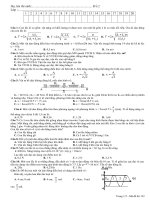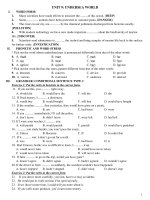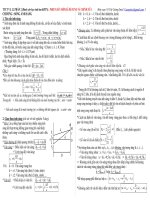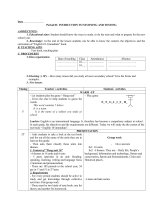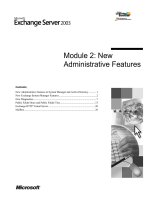handbook 2 new best seller
Bạn đang xem bản rút gọn của tài liệu. Xem và tải ngay bản đầy đủ của tài liệu tại đây (1.06 MB, 83 trang )
A Plain English
Handbook
How to create clear
SEC disclosure documents
By the Office of Investor Education and Assistance
U.S. Securities and Exchange Commission
450 5th Street, N.W.
Washington, DC 20549
August 1998
This handbook shows how you can use well-established techniques
for writing in plain English to create clearer and more informative
disclosure documents. We are publishing this handbook only for
your general information. Of course, when drafting a document for
filing with the SEC, you must make sure it meets all legal requirements.
Acknowledgments
This handbook reflects the work, ideas, and generosity of many
individuals and organizations at the SEC and in the private sector.
At the SEC, staff in the Divisions of Corporation Finance and
Investment Management, the Offices of Public Affairs and General
Counsel, and the Chairman’s Office provided insightful comments.
In particular, Commissioner Isaac C. Hunt Jr., Nick Balamaci, Barry
Barbash, Gregg Corso, Brian Lane, Diane Sanger, Jennifer Scardino,
Michael Schlein, Heidi Stam, and Tony Vertuno offered invaluable
advice and guidance.
Corporate officials and lawyers enthusiastically helped us to breathe
life into our plain English initiatives and this handbook. The Society
of Corporate Secretaries, the American Bar Association, and The Bond
Market Association invited us to conduct workshops where we tested
much of the information in the handbook. Kathleen Gibson, Peggy
Foran, Susan Wolf, Bruce Bennett, Jim McKenzie, Jeff Klauder,
Fred Green, Mark Howard, Pierre de Saint Phalle, Richard M. Phillips,
and Alan J. Davis contributed mightily to our efforts.
Special thanks to Warren Buffett for his support and preface, to Ken
Morris of Lightbulb Press, and to the talented staff at Siegel & Gale. I
am especially grateful to the staff of my office for giving me the time
and support I needed to work on the handbook.
Nancy M. Smith
Director, Office of Investor
Education and Assistance
a plain english handbook
Three people poured their hearts and minds into this handbook from
the start: Ann Wallace, from the Division of Corporation Finance;
Carolyn Miller, formerly of Siegel & Gale and now with the SEC; and
William Lutz, author and Professor of English at Rutgers University.
All of the credit and none of the blame goes to them.
And finally, many thanks to Chairman Arthur Levitt, who made it
all possible by putting plain English at the top of his agenda so that
investors might better understand their investments.
•
a plain english handbook
Table of Contents
Preface by Warren E. Buffett 1
Introduction by Arthur Levitt, Chairman 3
U.S. Securities and Exchange Commission
Chapter 1 What Is a “Plain English” Document? 5
Chapter 2 Getting Started 7
Chapter 3 Knowing Your Audience 9
Chapter 4 Knowing the Information You Need to Disclose 11
Chapter 5 Reorganizing the Document 15
Chapter 6 Writing in Plain English 17
Chapter 7 Designing the Document 37
Chapter 8 Time-Saving Tips 55
Chapter 9 Using Readability Formulas and Style Checkers 57
Chapter 10 Evaluating the Document 59
Chapter 11 Reading List 61
Chapter 12 Keeping in Touch with Us 63
Appendix A Plain English at a Glance 65
The SEC’s Plain English Rules—an Excerpt 66
Appendix B Plain English Examples 69
“Before” and “After” Filings with Notes 70
a plain english handbook
a plain english handbook
Preface
This handbook, and Chairman Levitt’s whole drive to encourage “plain
English” in disclosure documents, are good news for me. For more than
forty years, I’ve studied the documents that public companies file. Too
often, I’ve been unable to decipher just what is being said or, worse yet,
had to conclude that nothing was being said. If corporate lawyers and
their clients follow the advice in this handbook, my life is going to
become much easier.
There are several possible explanations as to why I and others some-
times stumble over an accounting note or indenture description. Maybe
we simply don’t have the technical knowledge to grasp what the writer
wishes to convey. Or perhaps the writer doesn’t understand what he or
she is talking about. In some cases, moreover, I suspect that a less-than-
scrupulous issuer doesn’t want us to understand a subject it feels legally
obligated to touch upon.
Perhaps the most common problem, however, is that a well-intentioned
and informed writer simply fails to get the message across to an
intelligent, interested reader. In that case, stilted jargon and complex
constructions are usually the villains.
This handbook tells you how to free yourself of those impediments to
effective communication. Write as this handbook instructs you and you
will be amazed at how much smarter your readers will think you have
become.
by Warren E. Buffett
a plain english handbook 1
One unoriginal but useful tip: Write with a specific person in mind.
When writing Berkshire Hathaway’s annual report, I pretend that I’m
talking to my sisters. I have no trouble picturing them: Though highly
intelligent, they are not experts in accounting or finance. They will
understand plain English, but jargon may puzzle them. My goal is
simply to give them the information I would wish them to supply me
if our positions were reversed. To succeed, I don’t need to be
Shakespeare; I must, though, have a sincere desire to inform.
No siblings to write to? Borrow mine: Just begin with “Dear Doris
and Bertie.”
•
a plain english handbook 2
Introduction
Investors need to read and understand disclosure documents to
benefit fully from the protections offered by our federal securities
laws. Because many investors are neither lawyers, accountants, nor
investment bankers, we need to start writing disclosure documents
in a language investors can understand: plain English.
The shift to plain English requires a new style of thinking and writing,
whether you work at a company, a law firm, or the U.S. Securities and
Exchange Commission. We must question whether the documents we
are used to writing highlight the important information investors need
to make informed decisions. The legalese and jargon of the past must
give way to everyday words that communicate complex information
clearly.
The good news is that more and more companies and lawyers are
using plain English and filing documents with the SEC that others
can study, use, and improve upon. With the SEC’s plain English rules
in place, every prospectus will have its cover page, summary, and risk
factors in plain English.
The benefits of plain English abound. Investors will be more likely to
understand what they are buying and to make informed judgments
about whether they should hold or sell their investments. Brokers and
investment advisers can make better recommendations to their clients
if they can read and understand these documents quickly and easily.
by Arthur Levitt
Chairman, U.S. Securities
and Exchange Commission
a plain english handbook 3
Companies that communicate successfully with their investors form
stronger relationships with them. These companies save the costs of
explaining legalese and dealing with confused and sometimes angry
investors. Lawyers reviewing plain English documents catch and correct
mistakes more easily. Many companies have switched to plain English
because it’s a good business decision. They see the value of communi-
cating with their investors rather than sending them impenetrable
documents. And as we depend more and more on the Internet and
electronic delivery of documents, plain English versions will be easier
to read electronically than legalese.
The SEC’s staff has created this handbook to help speed and smooth
the transition to plain English. It includes proven tips from those in
the private sector who have already created plain English disclosure
documents. This handbook reflects their substantial contributions and
those of highly regarded experts in the field who were our consultants
on this project, Dr. William Lutz at Rutgers University and the firm of
Siegel & Gale in New York City.
But I hasten to add that the SEC has not cornered the market on plain
English advice. Our rules and communications need as strong a dose
of plain English as any disclosure document. This handbook gives you
some ideas on what has worked for others, but use whatever works
for you.
No matter what route you take to plain English, we want you to produce
documents that fulfill the promise of our securities laws. I urge you
—in long and short documents, in prospectuses and shareholder
reports—to speak to investors in words they can understand. Tell
them plainly what they need to know to make intelligent investment
decisions.
•
a plain english handbook 4
1
What Is a “Plain
English” Document?
We’ll start by dispelling a common misconception about plain English
writing. It does not mean deleting complex information to make the
document easier to understand. For investors to make informed
decisions, disclosure documents must impart complex information.
Using plain English assures the orderly and clear presentation of
complex information so that investors have the best possible chance
of understanding it.
Plain English means analyzing and deciding what information
investors need to make informed decisions, before words, sentences,
or paragraphs are considered. A plain English document uses words
economically and at a level the audience can understand. Its sentence
structure is tight. Its tone is welcoming and direct. Its design is visually
appealing. A plain English document is easy to read and looks like it’s
meant to be read.
a plain english handbook 5
This handbook’s purpose
This handbook gives you practical tips on how to create plain English
documents. All of these were born of experience. They come from
experts and those who have already written or rewritten their docu-
ments in plain English.
As with all the advice in this handbook, feel free to tailor these tips to
your schedule, your document, and your budget. Not all of the tips will
apply to everyone or to every document. Pick and choose the ones that
make sense for you.
Some of our tips cover very basic mechanical issues, like how to photo-
copy your working draft. We’ve included them because they were
learned the hard way and have saved people time, money, and aggrava-
tion. You’ll see them listed in Chapter 8, titled “Time-Saving Tips.”
This handbook is by no means the last word on plain English. We
expect to change it and add more tips as we learn more about writing
securities documents in plain English. So please keep notes on your
experiences and copies of your original and rewritten language. We
want to hear from you and include your tips and rewrites in the next
edition.
Finally, we encourage you to give this handbook out freely. It is not
copyrighted, so you can photocopy it without fear of penalty.
•
a plain english handbook 6
Getting Started
Assemble the team or move ahead on your own
As with a lot of things in life, it’s the preparation that often determines
the success or failure of an effort to write documents in plain English.
Many of you routinely select a team to think and talk about how to write
a document from scratch or rewrite an existing document. Or you may
do it on your own. In that case, rest assured that one person can do it
alone.
The list below describes the types of people who have participated in
successful plain English teams. We’re not suggesting that you need to select
everyone listed. Some will not apply to your company or your situation.
The people you select, and the point at which you involve them in your
plain English project, will depend on your document, your schedule,
and your budget.
• A team leader who has the authority to make decisions that keep
the project moving forward and bring it to a successful conclusion.
(More than one plain English project has faltered because the team
leader has not had this level of authority.) The team leader may be
a company’s or an underwriter’s lawyer.
• A lead writer who ensures the document uses a logical structure and
simple, clear language. If more than one person is drafting sections of
the document, the lead writer makes sure the final draft has a consis-
tent tone and the individual parts form a coherent whole.
• Lawyers for the company or the underwriter who know what informa-
tion must be included and why.
a plain english handbook 7
2
• An investor relations expert who knows firsthand the financial sophis-
tication of your investors. Investor relations people know which ques-
tions investors typically ask and where past disclosure documents have
failed to make information clear.
• A compliance officer who can lend guidance to the writer and who
knows, along with your lawyers, what information must be included.
• A production and operations person who understands the mechanics
and costs of printing and mailing your document, so that your
improved document doesn’t get ahead of your in-house capabilities or
budget.
• A marketing person who may have market survey research or polls on
your investors. Also, the marketing department is usually attuned to
the terminology that your investors can readily understand.
• An information designer who is a graphic designer trained to work
closely with the writers and to think about how to present complex
information visually.
Select documents
You may want to consider these issues as you start writing in plain
English:
• How long is the document?
• Will you write all of it, or only sections of it, in plain English?
• How much time do you have before you need to file your document?
You will also want to gather and distribute other documents that your
company has written for investors. It’s likely that your company has
already used plain English in its glossy annual reports and other com-
munications prepared especially for investors. These documents may
save you time by showing you the type of language your company is
already comfortable using.
•
a plain english handbook 8
Knowing Your Audience
Knowing your audience is the most important step in assuring that
your document is understandable to your current or prospective
investors. To write understandable documents, you need to gauge the
financial sophistication of your investors.
Through polls and other market survey research tools, some companies
know the demographics of their investors well. Other companies rely on
their investor relations staff or their underwriters to describe who has
bought, or is likely to buy, their securities.
Using whatever information is available, you can create a profile
of your investors or prospective investors based on the following
questions:
• What are their demographics—age, income, level of education, and
job experience?
• How familiar are they with investments and financial terminology?
• What investment concepts can you safely assume they understand?
• How will they read the document for the first time? Will they read it
straight through or skip around to the sections that interest them?
• Will they read your document and your competitors’ side by side?
• How will they use the document while they own the security?
What information will they be looking for later, and is it easy to find?
a plain english handbook 9
3
“One must consider also
the audience the reader
is the judge.”
Aristotle
Rhetoric
Your investors or prospective investors may include individuals and
institutions with varying degrees of financial sophistication. While your
audience will include analysts and other industry experts, you may want
to keep in mind that your least sophisticated investors have the greatest
need for a disclosure document they can understand. Some companies
have faced the differing needs of their investors and other audiences
by making basic educational information visually distinctive from the
rest of the text so that sophisticated investors can easily recognize and
scan it.
Once you’ve drawn a profile of your investors, keep it constantly in
mind. Some writers keep a photo of a typical investor to make sure they
don’t lose sight of their readers.
After analyzing who your investors are, you can turn to the document
you want to write or rewrite.
•
10 a plain english handbook
Knowing the
Information You Need
to Disclose
The steps outlined in this section have been used successfully by
others who have written disclosure documents in plain English. As we
said earlier, feel free to tailor these steps to your own schedule and
team. This is one approach if you are rewriting an existing document,
but others may work equally well.
Read and outline the current document
Read the entire document once without making any notes or comments
on the text. This should give you a general understanding of the
information covered in the document and make your next read more
productive.
When you read it the second time, make notes on what information
is covered and any questions you have. Your notes will also help you to
assess if information flows through your document in a logical order.
As you read, consider the following:
• Will the investors understand the language?
• Does the document highlight information that is important to
investors?
• Is any important information missing?
• Does the document include information that is not legally required
and will not help investors make informed decisions?
4
For time-saving tips on how to
outline and reorganize your
document, read Chapter 8 on
page 55.
a plain english handbook 11
“Writers must therefore
constantly ask:
What am I trying to say?
Surprisingly often they
don’t know. They must
look at what they have
written and ask:
Have I said it?”
William Zinsser
On Writing Well
Meet to resolve questions
Meet with the authors of the original document or others who under-
stand it and any members of the team who can help to answer the
questions you wrote in the margins. Besides the obvious reason for
the meeting, another more important goal is
to question the need for everything that appears in the document.
“Because it’s always been there” is not reason enough to keep it in your
draft. Since much of the language in these documents is recycled from
older (or another company’s) documents, often no one knows who
initially wrote it or why it is needed now. If you’ve done your legal
research and no one knows why the information is important or
required, consider taking it out.
Eliminate redundant information
Question the need for repeating any information. Reading the same
material two or three times can bore and even trouble readers. Most
readers skip over paragraphs if they think they’ve read them before.
If you cut down on repetitious paragraphs or sentences, you’ll not only
earn the gratitude of your reader, you’ll reduce printing and mailing
costs.
Discuss the cover page and the summary
A cover page should be an introduction, an inviting entryway into your
document, giving investors some key facts about your offering, but not
telling everything all at once. If it looks dense and overgrown with
thorny details, no one will want to pick it up and start reading. If it
looks like a legal document written by lawyers and for lawyers, many
investors will not even attempt to read it.
To create an inviting cover page, you’ll need to strip away much of what
is conventionally placed there, but which is not required.
12 a plain english handbook
As you review your cover page, question why each item of information
is there. It may be important, but does it have to be on the cover page?
You usually have a substantial document following the cover page—let
some of those other pages carry the information load in logical order.
What would be helpful for investors to see on this page? Look through
your investors’ eyes and you’ll make better decisions about where to
place information.
The same goes for the summary. A summary should orient the reader,
highlighting the most important points that are presented in greater
detail in the prospectus. Many summaries now seem as long as the
document itself and consist merely of paragraphs copied straight from
the body of the document.
Use defined terms sparingly
Although customary, introducing defined terms on the cover page and
in the summary discourages many readers from getting beyond the first
pages. Overwhelmed with memorizing a new and unnatural vocabulary,
and bothered by constantly having to flip back and hunt for the first
time a defined term’s definition appears, many an investor will not stick
with the document. One plain English expert has advised, don’t let a
shortcut for the writer become a roadblock for the reader.
•
a plain english handbook 13
14 a plain english handbook
Reorganizing the
Document
A few principles of good organization apply universally.
First, present the big picture before the details. Prospectuses routinely
start with a detailed description of the securities. You may read pages
before you find out what the company produces, or why it is merging or
spinning off a subsidiary. It’s hard to absorb the details if you don’t
know why they are being given to you. Imagine trying to put together a
complicated jigsaw puzzle without first seeing the picture of the com-
pleted puzzle. An individual piece of information means more to your
readers if they know how it fits into the big picture.
Second, use descriptive headers and subheaders to break your
document up into manageable sections. Prospectuses impart a lot of
information. If you present the information in bite-sized pieces, it’s
easier to digest. Make sure your headings tell the reader what the
upcoming sections will cover. Headings like “general” or “background”
aren’t especially helpful.
Third, always group related information together. This helps you
identify and eliminate repetitious information.
a plain english handbook 15
5
Fourth, your audience’s degree of investment expertise will affect how
you organize the document. If you are writing for financially unsophis-
ticated investors, your document’s overall organization may take an
educational approach. You may need to explain industry terms or
concepts where they first appear.
Fifth, review your document by taking a good look at the flow of infor-
mation from beginning to end. Start making decisions on how the con-
tent should be moved around into a new and logical order based on:
• the audience profile
• the notes you made in the margins
• the decisions you’ve made on your cover page and summary
• the information you’ve learned in answering your questions
Once you have finished physically reorganizing the document, you may
want to write an outline of your new organization. Your outline can
later become your table of contents.
You’re now ready to start rewriting your document in plain English.
And, speaking of writing…
•
16 a plain english handbook
6
Writing in
Plain English
We thought it would be helpful to list the most common problems
we’ve encountered with disclosure documents.
Common problems
• Long sentences
• Passive voice
• Weak verbs
• Superfluous words
• Legal and financial jargon
• Numerous defined terms
• Abstract words
• Unnecessary details
• Unreadable design and layout
In the following pages we offer some ways to fix these problems.
a plain english handbook 17
We’ve listed just some of the
many books on how to write
clearly in Chapter 11. We urge
you to consult them, too.
“Straightforward
sentences sound unim-
pressive to many writers,
and officialese, creating
tin ears, perpetuates
itself.”
Claire Kehrwald Cook
Line by Line
For example, here’s a common sentence found in prospectuses:
NO PERSON HAS BEEN AUTHORIZED TO GIVE ANY
INFORMATION OR MAKE ANY REPRESENTATION OTHER
THAN THOSE CONTAINED OR INCORPORATED BY REFER-
ENCE IN THIS JOINT PROXY STATEMENT/PROSPECTUS,
AND, IF GIVEN OR MADE, SUCH INFORMATION OR REPRE-
SENTATION MUST NOT BE RELIED UPON AS HAVING BEEN
AUTHORIZED.
Here’s one possible plain English rewrite:
You should rely only on the information contained in this document
or that we have referred you to. We have not authorized anyone to
provide you with information that is different.
The plain English rewrite uses everyday words, short sentences, active
voice, regular print, and personal pronouns that speak directly to the
reader.
Do you think the rewrite captures the meaning of the original? Would
you write it differently?
Throughout this chapter, you’ll find “before” examples from disclosure
documents with plain English “after” examples to illustrate specific
principles of plain English. Since some of the “before” examples con-
tain ambiguities that can be successfully resolved only by studying their
context in a particular document, we did not attempt to provide rewrites
to cover every interpretation. We encourage you to write your own plain
English versions to fit your views and your needs. We don’t want to
create a new generation of plain English “boilerplate.”
Although the principles that follow may sound deceptively simple, if
you use them, your writing will improve dramatically.
18 a plain english handbook
Use the active voice with strong verbs
The plodding verbosity of most disclosure documents makes readers
yearn for clear words and short sentences. The quickest fix lies in using
the active voice with strong verbs. Strong verbs are guaranteed to liven
up and tighten any sentence, virtually causing information to spring
from the page. When you start to rewrite or edit your work, highlighting
all the verbs can help. You may be surprised by the number of weak
verbs, especially forms of “to be” or “to have” that you’ll find.
The time you spend searching for a precise and strong verb is time well
spent. When a verb carries more meaning, you can dispense with many
of the words used to bolster weak verbs.
Weak verbs keep frequent company with two more grammatical
undesirables: passive voice and hidden verbs. In tandem, they add
unnecessary length and confusion to a sentence.
The active and passive voices
If you need it, here’s a quick refresher on the active and passive voice.
active
The investor buys the stock.
In the active voice, the subject of the sentence, the investor, performs
the action, buying the stock.
passive
The stock is bought by the investor.
In the passive voice the subject, the stock, is acted upon. The person or
the thing doing the action is introduced with “by.” But sometimes, the
person or thing doing the action is deleted, leading to
passive with agent deleted
The stock is bought.
You don’t know who bought the stock. You’ll find many examples of the
“passive with agent deleted” in disclosure documents.
Readers understand sentences in the active voice more quickly and
easily because it follows how we think and process information. Many
times the passive voice forces readers to take extra mental steps as they
convert the passive into the active.
“A rambling, unwieldy sentence
generally hangs from an
inert…vague, actionless verb.”
Claire Kehrwald Cook
Line by Line
a plain english handbook 19

